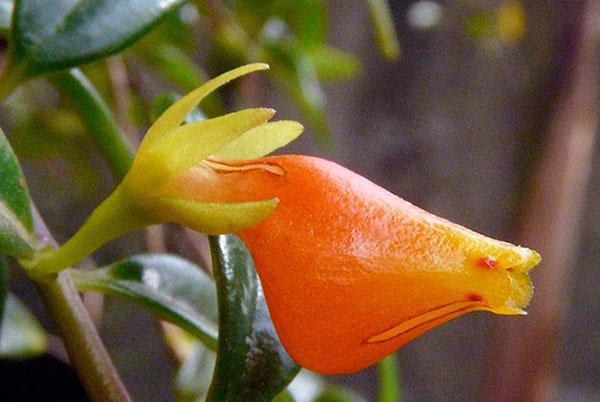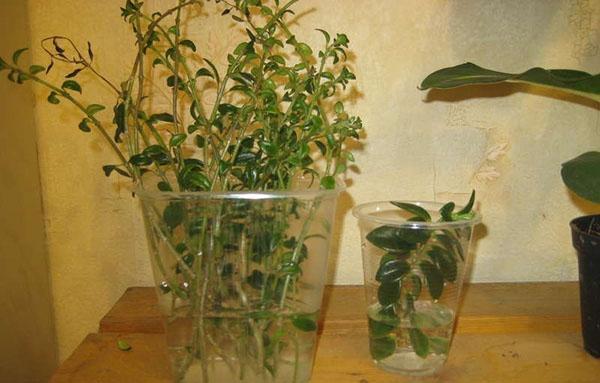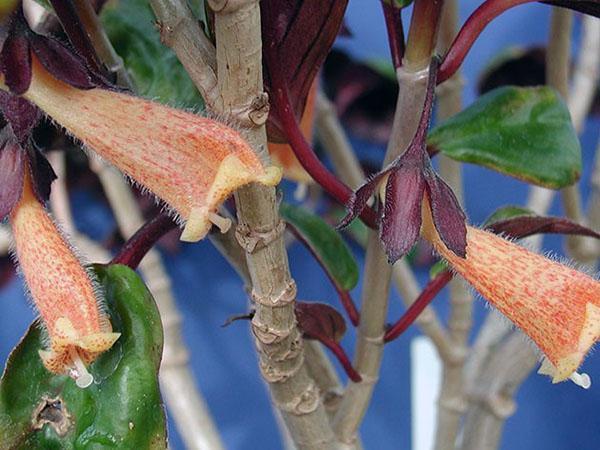Pruning and reproduction of nematanthus at home
 Nematanthus (lat. Nematanthus) belongs to the Gesneriev family and is a semi-shrub, shrub, or grass up to 60 cm in height. Since this is an ampelous form, and besides there are very long creeping, hanging shoots, the nematanthus is pruned regularly.
Nematanthus (lat. Nematanthus) belongs to the Gesneriev family and is a semi-shrub, shrub, or grass up to 60 cm in height. Since this is an ampelous form, and besides there are very long creeping, hanging shoots, the nematanthus is pruned regularly.
Crown formation

Pruning is important for a dense and beautiful crown and abundant flowering. Lack of pruning leads to partial shedding of foliage and bare stems.
If the flower hibernates in a warm room, then the haircut should be repeated with the arrival of spring.
Reproduction of nematanthus
To propagate a flower, they use two methods: rooting cuttings and sowing seeds.
Vegetative way
 To do this, use the cuttings remaining after trimming the nematanthus. They should be about 8-10 cm long and have 4-8 internodes.
To do this, use the cuttings remaining after trimming the nematanthus. They should be about 8-10 cm long and have 4-8 internodes.
Only strong and thick cuttings from adult shoots should be taken. Material taken from young animals often rots and takes root poorly.
The stalk is properly prepared: tear off the 4 bottom leaves and make sure that the cut passes under the knot. Rooting can be carried out in sphagnum moss, water, peat or directly in the substrate.
 In the latter version, the planted branches are placed in a greenhouse, where the temperature is maintained at + 22-24 ºC. The roots grow back in 2-3 weeks, depending on the conditions of detention.
In the latter version, the planted branches are placed in a greenhouse, where the temperature is maintained at + 22-24 ºC. The roots grow back in 2-3 weeks, depending on the conditions of detention.
Carrying out the reproduction of nematanthus by cuttings, the rooted shoots are transplanted into separate pots with a loose, air- and moisture-permeable substrate (you can take a ready-made one for violets) and a good drainage layer
During planting, the stalk is positioned so that a node appears in the soil, from which air roots will then grow.
Nematanthuses are planted in a small pot, at the bottom of which a drainage layer is placed.  Young nematanthuses are transplanted annually. Upon reaching the age of 4, the procedure is carried out annually, and from the age of four - once every 2 years, remembering each time to pick up a pot larger than the previous one by 1-2 cm in diameter.
Young nematanthuses are transplanted annually. Upon reaching the age of 4, the procedure is carried out annually, and from the age of four - once every 2 years, remembering each time to pick up a pot larger than the previous one by 1-2 cm in diameter.
Seed method
 For the propagation of nematanthus seeds (they ripen in capsules, are very small in size and resemble dust), the latter are poured onto a white sheet and sown in a previously prepared moist soil, gently tapping with a finger on the paper, evenly distributing over the entire surface. After that, the soil is covered with glass, and the pot (container) with a drainage hole is placed on a pallet. It is through him that future sprouts will be watered. When the seeds hatch, the glass begins to be periodically removed to allow the young to breathe.
For the propagation of nematanthus seeds (they ripen in capsules, are very small in size and resemble dust), the latter are poured onto a white sheet and sown in a previously prepared moist soil, gently tapping with a finger on the paper, evenly distributing over the entire surface. After that, the soil is covered with glass, and the pot (container) with a drainage hole is placed on a pallet. It is through him that future sprouts will be watered. When the seeds hatch, the glass begins to be periodically removed to allow the young to breathe.
 After 2 weeks, sprouts are dived with transplantation into separate pots, several seedlings in each. The grown young growth is looked after, as well as the adult plant. Pruning of nematanthus is carried out in a similar way. Flowering can be expected next year.
After 2 weeks, sprouts are dived with transplantation into separate pots, several seedlings in each. The grown young growth is looked after, as well as the adult plant. Pruning of nematanthus is carried out in a similar way. Flowering can be expected next year.
Content Issues
 With proper care, the plant is completely healthy and delights with abundant flowering. But the weakness resulting from negligence leads to problems.
With proper care, the plant is completely healthy and delights with abundant flowering. But the weakness resulting from negligence leads to problems.
Among them are:
- Mealybugs. These insects hide in the axils of the leaves, and they can only be detected when a cotton-like white bloom appears on the foliage. You can eliminate it by treating the plant with a cotton swab dipped in alcohol.
- Also, the plant can be affected by ticks, aphids and thrips, which love to feast on its juices, thereby infecting with various viral diseases.
It is possible to eliminate pests only by treating the entire plant with insecticides. For example, "Biotlin" and "Antitlin" are effective against aphids. Actellik will save from thrips and aphids,Fitoverm"," Akarin "," Kleschevit ".
 If the plant is kept in an area with high temperatures, poor ventilation and high humidity, fungi can attack it. You can fight the disease by following all the rules of care. If this does not help, you will have to treat with a fungicidal preparation, for example, "Fundazol".
If the plant is kept in an area with high temperatures, poor ventilation and high humidity, fungi can attack it. You can fight the disease by following all the rules of care. If this does not help, you will have to treat with a fungicidal preparation, for example, "Fundazol".
In addition to diseases and pests, nematanthus often suffers from:
- "Wet feet" at the same time low temperature in the cold season, drafts, a sharp drop in temperature, as well as from the drying out of the earth coma in the heat. This is fraught with foliage dumping.
- High indoor temperatures and low humidity at the same time can lead to dry leaf tips.
- The appearance of light brown spots on the leaves is the result of watering with cold water.
- If the foliage turns brown and eventually falls off, the reason lies in the ingress of water droplets on it.
Proper care, regular inspection for pests and diseases, and pruning will help you grow a beautiful lush plant that will thank you for your work with bright and abundant flowering.